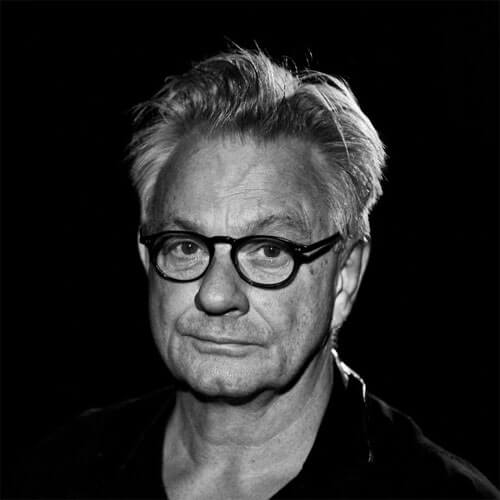Anders Petersen was born 1944 in Stockholm, Sweden. 14 years old his family moved to Karlstad in Värmland, where he met the artists ?Karin Bodland and Lars Sjögren.
In 1961 he stayed for some time in Hamburg in order to learn German and trying to write and paint. He didn’t take any pictures.
Five years later he met Christer Strömholm and became a student at his School of Photography in Stockholm. Strömholm was not just his teacher but also a close friend. Their friendship influenced him for life. In 1967 he starts photographing a bar called Café Lehmitz in Hamburg, close to Zeughausmarkt. He was photographing there for a period of almost three years and in 1970 he had his first soloexhibition over the bar in Café Lehmitz with 350 photographs nailed to the wall.
In 1973 he published his first book ”Gröna Lund”, about people in an amusementpark in Stockholm. In 1974 he graduated from the Swedish Filmschool,Dramatiska Institutet, in Stockholm. In 1978 he published ”Café Lehmitz ” in Germany. In 1984 the first book in a trilogy about locked instituations was published. The three books were about people in a prison, a nursing house, and a mental hospital. After photographing the mental hospital for three years he oriented himself towards a more free approach in a kind of diarylike photography.
During 2003 and 2004 Anders Petersen was appointed Professor of Photography in the School of Photography and Film at the University of Göteborg, Sweden. He regularly has workshops and exhibitions throughout Europe, Asia and in the USA. He has received numerous grants and rewards since the seventies. In 2003 Anders Petersen was elected the ”Photographer of the Year” by the International Photofestival in Arles.
In 2006 he was shortlisted as one of four for the ”Deutsche Börse Photography Prize”. In 2007 he received the ”Special Prize of the Jury” for his exhibition ”Exaltation of Humanity” by the third International Photofestival in Lianzhou, China.
In 2008 he received the ”Dr. Erich Salomon Award” by Deutsche Gesellschaft für Photographie, Germany. ”The Arles Contemporary Book Award for 2009? went to JH Engström and ?Anders Petersen’s collaborative book ”From Back Home” by Max Ström.?The book was nominated to ”The Best Photographic Book in Sweden, ?year 2009? and also Winner of Design Bronze Lion in Cannes. In 2010, he was in the jury for the BMW Prize at Paris Photo.
In 2012, nominated to the Swedish Photo Book Prize in Stockholm for ”SOHO”, and PhotoBook of the Year award for "City Diary" Paris Photo and the Aperture Foundation. Anders Petersen has his darkroom in Stockholm, Sweden.
Source: www.anderspetersen.se
Anders Petersen, one of Sweden’s most influential auteur photographers, sensitively blurs the boundaries between madness and normality in his artwork “Mental Hospital”. Petersen, who won international renown with his Hamburg Café Lehmitz series (1967-1970), spent several years photographing patients at a psychiatric hospital just south of Stockholm. His gaze is one of raw tenderness, conveying naked emotions with insightful poetry. Carried by a deep integrity, he takes the viewer to the limits of normality.
"It is the naked encounter, the raw, piercing confrontation with the Other and therefore with myself," Petersen said, describing his intention.
"I photograph people with whom I can identify and I feel attracted by people who live outside society. In all my photographs, I try, essentially, to create self-portraits." He is neither sentimental nor sensational. Instead, his images show a great respect for that which is enigmatic in people, for that which is hidden under the surface.
Petersen’s works have marked the history of photography. In 2003, he won the award “Photographer of the Year” at the festival "Rencontres de la Photographie" in Arles, and he was honored with the German Photography Society’s Dr.-Erich-Salomon prize in 2008 for his life’s work.
Source: Grundemark Nilsson Gallery

